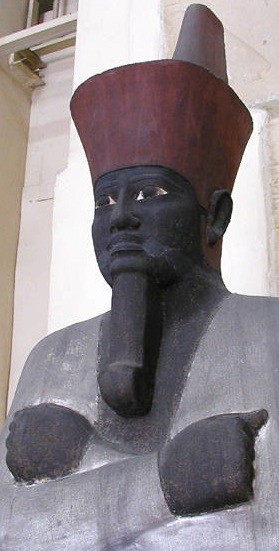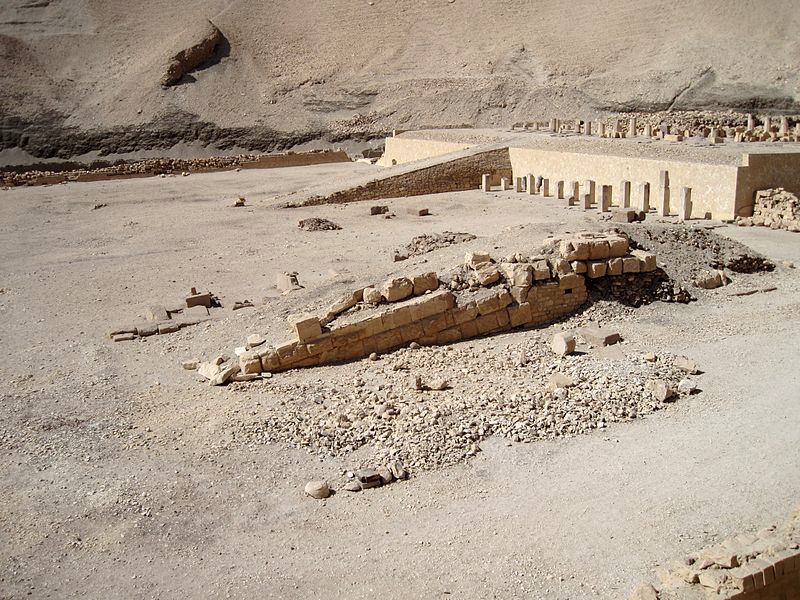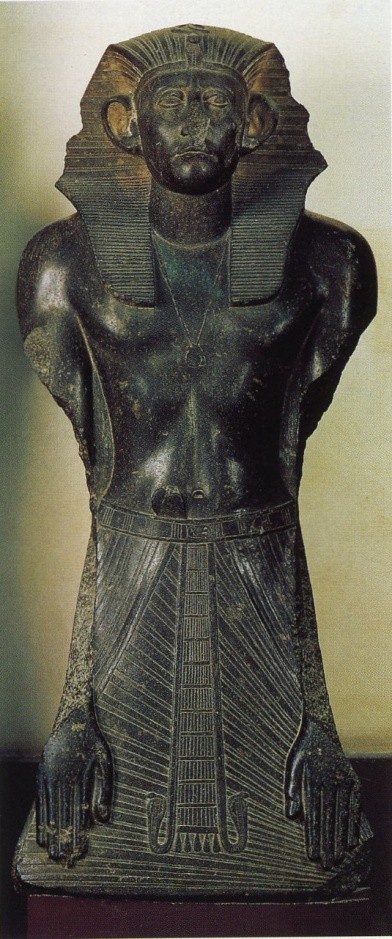3.3 Egypt-Middle Kingdom
Following the decentralized First Intermediate Period of roughly 150 years, Pharaoh Mentohotep II reunified Egypt to found the Middle Kingdom. With military expeditions, the pharaohs extended the boundaries of the state north to Lebanon and south to the second cataract of the Nile into a region known as Nubia. With this extension of territory, Egypt had access to more trade goods and the organization of trade shifted so that professional merchants took a leading role in developing new trade routes. These professional merchants paid taxes to the state, supporting further consolidation of power by the pharaohs and also infrastructural improvements like irrigation. During the Middle Kingdom, the pharaohs focused less on the building of massive pyramids and more on administrative reorganization, military expeditions, and infrastructural repair.


Image 3.19 is a painted limestone sculpture of Nebhepetre, also called Mentuhotep II which was discovered in the Bab el-Hosan. Mentuhotep ruled southern Egypt (Upper Egypt) from Aswan to the city of This, about 90 miles north of Thebes. He inherited a realm that had already spent many years in intermittent warfare, but he was able to unify the kingdom by retaining local rulers who stayed loyal to him. The reunification brought increased prosperity and stronger trade throughout the region. Mentuhotep also built several large temple complexes, including this one at Luxor. His reunification of Egypt earned him the title of the first pharaoh of the Middle Kingdom.

During the years of the Middle Kingdom, the power of the pharaoh was less certain. The golden years of the Old Kingdom were past. There was less income available to build huge pyramids, and times were more troubled. The art reflected this stressful change. Much of the royal sculpture shows pharaohs with furrowed brows and grim expressions, like image 3.21 of Sesostris III.
Disputes over succession and ineffectual rulers led into the Second Intermediate Period. Most notably, Egypt was invaded from both the north and the south during this period. The Hyksos invaded from the north in 1670 BCE. It is not certain where they came from, but they may have been Canaanites and Ammonites from Mesopotamia, or they may have been Bedouin tribesmen. It is certain that they were foreign to the region. They brought bronze and horse- drawn chariots, which allowed them to conquer parts of Lower Egypt and establish their own kingdom, one lasting about 100 years in the Nile Delta region. From the south, the Kingdom of Kush, based in Nubia, invaded and temporarily established control over Upper Egypt to Aswan. Thus, foreign rulers dominated much of Egypt during the Second Intermediate Period.
Attributions:
Berger, Eugene; Israel, George; Miller, Charlotte; Parkinson, Brian; Reeves, Andrew; and Williams, Nadejda, “World History: Cultures, States, and Societies to 1500” (2016). History Open Textbooks. 2.
References:
1. Photo by Iry-Hor, CC BY-SA 3.0. https://commons.wikimedia.org/w/index.php?title=Special:Search&limit=100&offset=0&profile=default&search=Mentuhotep+II&a dvancedSearch-current={}&ns0=1&ns6=1&ns12=1&ns14=1&ns100=1&ns106=1#/media/File:Mentuhotep_Closeup.jpg
2. Photo By Olaf Tausch, CC-BY-3.0. https://commons.wikimedia.org/w/index.php?search=Mortuary+temple+of+Mentuhotep&title=Special%3ASearch&go=Go&ns0=1& ns6=1&ns12=1&ns14=1&ns100=1&ns106=1#/media/File:Mentuhotep-Tempel_01.JPG
3. Photo by Kathleen J. Hartman, CC BY-NA-4.0.

